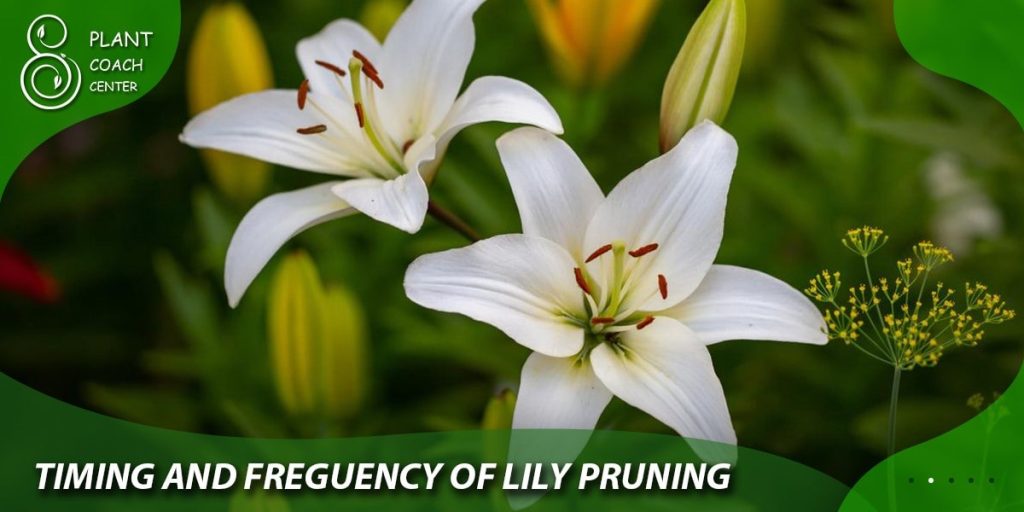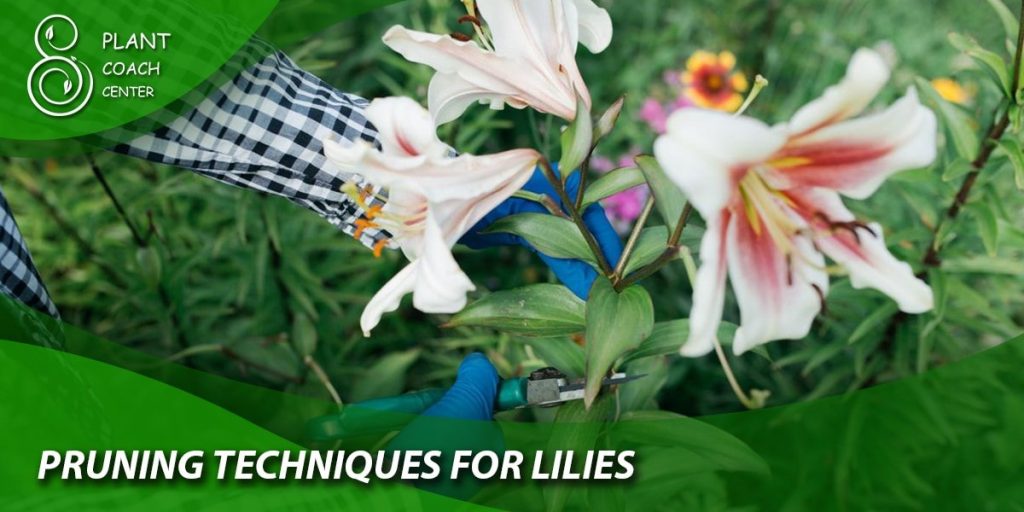When to Cut Back Lilies
When it comes to maintaining a vibrant and healthy garden, proper care of lilies is essential. Lilies are renowned for their exquisite beauty and captivating fragrance. Still, to ensure their optimal growth and longevity, it’s important to know when and how to prune them. This comprehensive guide will explore the best practices for pruning lilies, addressing common problems, and providing expert tips for promoting robust growth and stunning blooms.

Understanding Lily Growth Patterns
Lily Growth Stages
To effectively prune lilies, it is crucial to understand their growth patterns. Lilies go through several stages of growth, including dormancy, emergence, vegetative growth, and blooming. By recognizing these stages, you can determine the most appropriate times for pruning.
During dormancy, lilies are in a period of rest, typically in late fall or winter. This is when the above-ground foliage dies back, and the plant redirects its energy to the underground bulbs. Pruning during this stage helps prepare the lilies for their next growth cycle.
Factors Affecting Lily’s Growth
Various factors can influence the growth of lilies. Sunlight, temperature, soil conditions, and moisture levels are vital in determining when and how lilies should be pruned. Understanding the specific needs of your lilies will enable you to tailor your pruning practices accordingly.
Furthermore, different lily varieties may have unique growth requirements. Some lilies thrive in full sun, while others prefer partial shade. Awareness of these preferences will guide you in providing the best care for your specific lily cultivars.
Recognizing Different Lily Varieties
Lilies come in a wide range of varieties, each with distinctive characteristics. Common types include Asiatic lilies, Oriental lilies, Trumpet lilies, and Easter lilies, to name a few. Before pruning, it is essential to identify the specific variety you are working with, as different lilies may have slightly different pruning needs.
Asiatic lilies are known for their vibrant colors and early bloom times. Oriental lilies, on the other hand, produce larger, highly fragrant flowers and typically bloom later in the summer. Trumpet and Easter lilies boast trumpet-shaped blooms with an intense fragrance. Understanding the unique attributes of each variety will ensure proper pruning and care.
Signs and Indications for Pruning Lilies
Identifying Overgrown or Damaged Lilies
Pruning lilies becomes necessary when they become overgrown or show signs of damage. Over time, lilies can become crowded, with too many stems competing for limited resources. This can result in weaker growth and reduced flower production. Additionally, lilies may suffer damage from pests, diseases, or unfavorable environmental conditions.
Regular inspection of your lilies is crucial for early detection of any issues. Look for crowded clumps, weak or yellowing foliage, wilted or diseased stems, or signs of pest infestations. Pruning these damaged or overgrown parts will rejuvenate the plant and promote healthy growth.
Understanding the Benefits of Pruning
Pruning lilies offers several benefits for both the plants and the gardener. By removing dead or diseased foliage, you eliminate potential sources of infection and prevent the spread of diseases throughout the garden. Pruning also improves air circulation and sunlight penetration, reducing the risk of fungal growth and promoting overall plant health.
Moreover, pruning lilies helps maintain an aesthetically pleasing garden. Removing spent flowers and trimming overgrown stems enhances the plant’s appearance and encourages a tidy and well-maintained landscape. Pruning can also stimulate the production of more flowers, resulting in a more abundant and vibrant display.
Recognizing Signs of Stress or Disease
Like any other plant, Lilies can experience stress and fall victim to various diseases. Pruning can be an effective measure to address these issues. Stress factors such as inadequate watering, nutrient deficiencies, or extreme temperatures can weaken lilies, making them more susceptible to diseases and pests.
Be vigilant for signs of stress, such as stunted growth, discolored leaves, or wilting. Common lily diseases include botrytis blight, lily mosaic virus, and gray mold. If you observe any symptoms of these diseases, prompt pruning, and appropriate treatment are crucial to prevent further damage and ensure the plant’s survival.

Timing and Frequency of Lily Pruning
Pruning Based on Lily Growth Stages
Pruning lilies at the right time is essential for their health and growth. The timing of pruning largely depends on the growth stages of the lilies.
During the dormant stage in late fall or winter, prune lilies by cutting back the foliage to ground level. This allows the plant to conserve energy and prepare for its next growth cycle in the following season.
As the lilies emerge from dormancy and new shoots, appear in early spring, inspect the plants for any signs of damage or disease. Remove any damaged or diseased foliage, careful not to disturb the developing shoots. This early spring pruning sets the stage for healthy growth and abundant blooms.
During the growing season, it’s generally best to avoid extensive pruning. However, you can remove spent flowers by cutting them back to prevent seed formation and redirect the plant’s energy toward producing new blooms.
Seasonal Pruning: Spring, Summer, and Fall
- Spring Pruning: As mentioned earlier, spring pruning focuses on removing damaged or diseased parts of the lily plant. It is also an opportune time to divide overcrowded clumps if necessary. Gently lift the bulbs from the ground, separate them, and replant them at appropriate intervals to promote healthier growth.
- Summer Pruning: Summer is crucial for lily growth and blooming. During this period, pruning should be limited to deadheading, which involves removing spent flowers. By deadheading, you prevent the lilies from directing energy toward seed production, allowing them to channel it toward stronger root and bulb development.
- Fall Pruning: Towards the end of the growing season, as the foliage begins to yellow and die back, it’s time for fall pruning. Trimming the yellowed foliage to ground level helps prevent the spread of diseases. It prepares the lilies for their dormant period.
Frequency of Pruning for Different Lily Types
The frequency of pruning lilies may vary depending on the specific lily varieties and their growth characteristics. Some lilies require more frequent pruning to maintain vigor and prevent overcrowding, while others may need less intervention.
For instance, Asiatic lilies benefit from regular pruning to remove faded flowers and promote continuous blooming. By deadheading these lilies throughout the summer, you encourage the plant to produce new buds and extend the blooming period.
Oriental lilies, on the other hand, may not require deadheading as frequently. These lilies typically have larger blooms and a longer blooming period. However, removing any spent flowers is still important to maintain the plant’s appearance and prevent seed formation.
Trumpet and Easter lilies generally require minimal pruning. However, suppose you notice any damaged or diseased foliage. In that case, it’s crucial to remove those parts promptly to preserve the overall health of the plants.

Pruning Techniques for Lilies
Tools and Equipment Required for Pruning
Before delving into the actual pruning process, gathering the necessary tools and equipment is important. The right tools will make the pruning task more efficient and help you achieve clean and precise cuts. Here are some essential tools for lily pruning:
- Pruning shears or secateurs: These handheld tools are ideal for cutting stems, leaves, and flowers. Look for a sharp and sturdy pair that fits comfortably in your hand.
- Garden gloves: Protect your hands from thorns, prickles, and any potential skin irritations while pruning. Choose gloves that are flexible yet durable.
- Disinfectant solution: To prevent the spread of diseases, sterilize your pruning tools before and after each use. Prepare a mixture of one part bleach to nine parts water and dip your tools in it for a few minutes.
Step-by-Step Guide to Lily Pruning
Pruning lilies may seem intimidating, but by following a few simple steps, you can ensure successful pruning and maintain the health of your plants. Here’s a step-by-step guide:
- Preparation and Safety Measures
Before starting, put on your garden gloves to protect your hands. Ensure that your pruning tools are clean and sharp. This will result in cleaner cuts and minimize the risk of plant damage or disease transmission.
- Removing Dead or Diseased Foliage
Begin by inspecting the lily plant for any dead or diseased foliage. Dead leaves are typically yellow or brown and show no signs of life. Diseased foliage may have spots, discoloration, or signs of fungal growth.
Using your pruning shears, carefully remove the dead or diseased foliage at its base, near the main stem. Make clean cuts to avoid leaving stubs that could invite pests or diseases.
- Trimming Overgrown Stems and Leaves
Next, identify any stems or leaves that appear overgrown or excessively long. These can detract from the lily’s overall appearance and may lead to reduced blooming. Trim them back to a desirable length, keeping in mind the overall shape and balance of the plant.
When trimming stems, cut just above a healthy leaf node or bud. This will encourage new growth from that point and maintain a tidy appearance.
- Promoting Balanced Growth
To ensure balanced growth, consider removing lateral buds or shoots competing for resources. These secondary shoots may divert energy from the main stem, resulting in weaker growth and smaller flowers.
Selectively removing some of these lateral shoots can redirect the plant’s energy toward the main stem, promoting stronger growth and larger blooms.
Special Considerations for Specific Lily Varieties
Asiatic Lilies
- Pruning Asiatic Lilies for Optimal Growth
Asiatic lilies are known for their vibrant colors and early blooming. To ensure optimal growth and continuous flowering, regular pruning is beneficial. Deadheading is particularly important for Asiatic lilies, as it encourages the production of new buds and extends the blooming period.
After the flowers have faded, use your pruning shears to remove the spent blooms by cutting them back to a healthy leaf node. This redirects the plant’s energy toward developing new flowers. Be careful not to damage the emerging buds while deadheading.
- Dealing with Pests and Diseases
While pruning, inspect your Asiatic lilies for signs of pests such as aphids, lily beetles, or mites. If you notice any infestations, remove the affected parts of the plant and consider using organic pest control methods to manage the problem. Regularly monitoring your lilies for pests and diseases helps prevent major outbreaks and ensures healthier plants.
Oriental Lilies
- Pruning Oriental Lilies for Healthy Blooms
Oriental lilies are known for their large, highly fragrant blooms that add a touch of elegance to any garden. When pruning Oriental lilies, focus on removing spent flowers to prevent seed formation and encourage the plant to direct its energy toward bulb development.
After the flowers have faded, use your pruning shears to carefully remove them by cutting just above a leaf node. Avoid cutting into the stem or damaging the surrounding foliage. This deadheading practice keeps the plant looking tidy and promotes continuous blooming.
- Addressing Common Problems and Challenges
Oriental lilies may be susceptible to botrytis blight or lily mosaic virus. If you observe any signs of these diseases, promptly remove the affected parts, disinfect your pruning tools, and dispose of the diseased material in a sealed bag to prevent further spread.
Additionally, Oriental lilies may require staking or support as their tall stems can be prone to bending or snapping under the weight of the flowers. Install stakes early in the growing season to provide adequate support and prevent damage.
Trumpet and Easter Lilies
- Pruning Tips for Trumpet and Easter Lilies
Trumpet and Easter lilies are known for their impressive trumpet-shaped blooms and intense fragrance. These lilies generally require minimal pruning, focusing mainly on removing damaged or diseased foliage.
Inspect your Trumpet and Easter lilies regularly for signs of damage or disease. If you identify any affected leaves or stems, use your pruning shears to carefully remove them at the base, making clean cuts. This will help maintain the overall health and appearance of the plants.
- Ensuring Strong and Vibrant Flowers
To ensure strong and vibrant flowers, it’s important to provide adequate care and attention to Trumpet and Easter lilies. This includes regular watering, well-draining soil, and protection from extreme weather conditions. Maintaining optimal growing conditions can minimize the risk of stress or disease, resulting in healthier and more beautiful blooms.

Addressing Common Lily Problems
Common Diseases and Pests Affecting Lilies
While lilies are generally resilient plants, they can still fall victim to certain diseases and pests. Being aware of these common problems and knowing how to address them will help you maintain the health and vitality of your lilies.
- Identifying and Treating Lily Diseases
- Botrytis Blight: Botrytis blight, or gray mold, is a fungal disease that affects lilies, causing browning and wilting of flowers and foliage. To prevent the spread of the disease, promptly remove infected plant parts and ensure good air circulation around the lilies. Consider applying a fungicide if the disease persists.
- Lily Mosaic Virus: A viral disease that can cause stunted growth, mottling, or streaking of leaves and deformed flowers. Unfortunately, there is no cure for this disease. If you suspect a lily is infected, removing and destroying the entire plant is best to prevent the spread to other lilies.
- Effective Pest Control Methods
- Lily Beetles: Lily beetles are bright red insects that feed on lily foliage, causing defoliation and weakening the plant. Handpick the beetles and their larvae from the lilies and drop them into a container of soapy water. Regularly inspect the plants and remove any beetles to prevent further damage.
- Aphids: Small, soft-bodied insects can quickly multiply and suck sap from lily plants, causing distorted growth and yellowing leaves. Use a strong stream of water or insecticidal soap to dislodge and control aphids. Ladybugs and lacewings are natural predators that help keep aphid populations in check.
Dealing with Environmental Factors
- Managing Sunlight, Temperature, and Humidity
Depending on the variety, lilies generally thrive in full sun to partial shade. Ensure that your lilies receive adequate sunlight for healthy growth and blooming. However, in areas with intense heat, some lilies may benefit from partial shade or protection from the afternoon sun to prevent scorching.
Extreme temperature fluctuations or frost can damage lilies. Consider applying a layer of mulch around the base of the plants to insulate the soil and protect the bulbs from temperature extremes.
- Preventing Soil-related Issues
Lilies prefer well-draining soil to prevent waterlogging and root rot. If you have heavy clay soil, amend it with organic matter such as compost or peat moss to improve drainage. Adequate drainage is crucial for preventing fungal diseases and promoting healthy root development.
Avoid overwatering lilies, as excessive moisture can lead to root rot and other water-related issues. Water the plants deeply but less frequently, allowing the top few inches of soil to dry out between waterings.
Advanced Lily Care Techniques
Supporting Lily Growth with Fertilization
Fertilization is vital in promoting healthy growth and vibrant blooms in lilies. Here are some tips for effectively fertilizing your lilies:
- Timing: Apply a slow-release, balanced fertilizer in early spring when new growth begins. This provides the necessary nutrients to support the lilies throughout the growing season.
- Application: Follow the instructions on the fertilizer packaging for the recommended dosage. Spread the fertilizer evenly around the base of the plants, avoiding direct contact with the foliage. Water the area thoroughly after applying the fertilizer to help it reach the root zone.
- Frequency: Repeat the fertilization process every four to six weeks during the growing season. This ensures a continuous supply of nutrients to support the lilies’ growth and flowering.
Mulching and Watering Practices
Proper mulching and watering techniques contribute to lilies’ overall health and moisture management. Consider the following tips:
- Mulching: Apply a layer of organic mulch, such as wood chips or shredded bark, around the base of the lilies. Mulch helps conserve soil moisture, suppresses weed growth, and regulates soil temperature. Maintain a mulch layer of about 2-3 inches, avoiding direct contact with the lily stems.
- Watering: Lilies require consistent moisture but should not be overly saturated. Water deeply but infrequently, allowing the top few inches of soil to dry out between waterings. Avoid overhead watering, as wet foliage can encourage disease development. Instead, use a soaker hose or drip irrigation system to deliver water directly to the soil.
Enhancing Lily’s Health through Companion Planting
Companion planting involves strategically placing compatible plants near lilies to provide benefits such as pest control, pollination, or shading. Consider the following companion planting options for lilies:
- Alliums: Planting alliums, such as chives or garlic, near lilies, can help deter pests like aphids and lily beetles. These aromatic plants act as natural repellents.
- Marigolds: Marigolds are known for their pest-repellent properties. Planting them around lilies can help deter harmful insects and nematodes.
- Daylilies: Daylilies make excellent companions for lilies, as they provide additional foliage and flowers that can help shade the lily bulbs and protect them from excessive heat.
Companion planting not only enhances the health of lilies but also adds visual interest and diversity to your garden.

Preparing Lilies for Winter
Fall Pruning and Preparation
As the growing season comes to a close and colder temperatures approach, it’s important to prepare your lilies for winter dormancy. Follow these steps to ensure the health and survival of your lilies:
- Fall Pruning: After the foliage has turned yellow or brown in late fall, prune your lilies by cutting back the stems to ground level. Remove dead or decaying foliage to prevent the spreading of diseases and pests during the dormant period.
- Clean-up: Dispose of the pruned foliage and plant debris away from your garden to prevent overwintering pests and diseases. Clear the area around the lilies to discourage rodents from nesting near the bulbs.
Protecting Lilies from Cold Temperatures
Lilies are generally hardy, but certain varieties may benefit from additional protection during harsh winter conditions. Consider the following measures to safeguard your lilies:
- Mulching: Apply an insulating mulch over the lily bulbs, such as straw or shredded leaves. This helps regulate soil temperature and protects freezing and thawing cycles. Maintain a layer of mulch about 4-6 inches deep.
- Container Plants: If you’re growing lilies in containers, move them to a sheltered location, such as a garage or shed, before the first frost. Ensure the storage area remains cool but frost-free throughout winter.
- Snow Cover: In regions with heavy snowfall, the snow acts as insulation for the lily bulbs. Allow the snow to accumulate naturally over the garden bed, providing an extra layer of protection. Avoid piling heavy snow directly on top of the lilies, as this can cause damage.
Storing and Overwintering Lilies
Some lily varieties, such as tender or tropical types, may not be winter-hardy in certain climates. In such cases, lifting and storing the bulbs for winter is necessary. Follow these steps for successful overwintering:
- Lift the Bulbs: Carefully dig up the lily bulbs using a garden fork or shovel after fall pruning. Gently remove any excess soil, taking care not to damage the bulbs.
- Cleaning and Drying: Inspect the bulbs for any signs of damage or disease. Remove any remaining foliage and allow the bulbs to dry for a few days in a well-ventilated area. Dust them with a fungicidal powder to prevent fungal infections during storage.
- Storage Conditions: Place the dried bulbs in a cool, dark, and well-ventilated location for the winter. Ideal storage temperatures range from 40 to 50°F (4 to 10°C). You can store them in a mesh bag, paper bag, or shallow container filled with peat moss or vermiculite to maintain humidity levels.
- Spring Planting: In early spring, as the risk of frost has passed, replant the stored bulbs in the garden, following the recommended planting depth and spacing for each lily variety.
Last words
Pruning lilies is essential for maintaining their health, promoting robust growth, and ensuring a stunning display of blooms. By understanding the growth patterns, timing, and techniques of lily pruning, you can effectively care for your plants and address common problems.
Consider the specific needs of different lily varieties, such as Asiatic lilies, Oriental lilies, Trumpet lilies, and Easter lilies. Each variety may have unique pruning requirements and potential challenges.
In addition to pruning, addressing common lily problems, such as diseases and pests, is crucial. Regular inspections, proper plant care, and timely interventions can help prevent and manage these issues, ensuring your lilies’ long-term health and beauty.
Advanced techniques, such as fertilization, mulching, watering practices, and companion planting, can further enhance the growth and vitality of your lilies. You can enjoy a bountiful and flourishing lily garden by providing optimal growing conditions and proper care.
Lastly, taking appropriate measures to prepare and protect your lilies is vital as winter approaches. If necessary, fall pruning, providing insulation, and storing tender bulbs will help ensure their survival and a successful return in the following spring.
By incorporating these practices into your lily care routine, you can cultivate a garden filled with healthy, vibrant, and breathtaking lilies year after year.
Remember, gardening is an art that requires observation, patience, and a touch of intuition. As you gain experience and develop your gardening style, you’ll become adept at determining the precise timing and techniques for pruning lilies in your specific growing conditions.
Enjoy the journey of tending to your lilies, and revel in the joy they bring as they grace your garden with their remarkable beauty and captivating fragrance.
When is the best time to prune lilies?
Late fall or winter during the dormant stage.
How often should I prune my lilies?
Regularly deadhead spent flowers and perform maintenance pruning as needed.
Do all lilies require the same pruning techniques?
No, different lily varieties may have specific pruning requirements.







